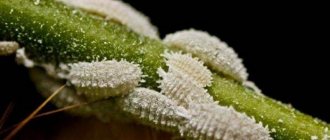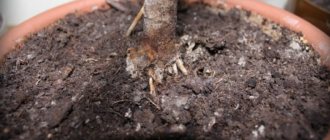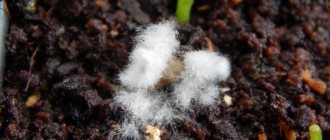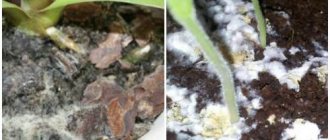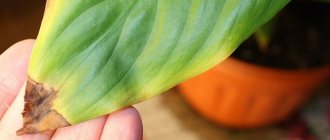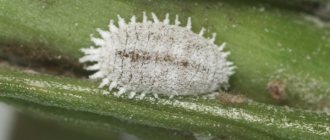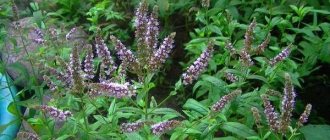Many people grow flowers in pots. This is both beautiful and useful. But sometimes owners encounter the following misfortune, like a white coating on the ground in pots. As experts say, the very fact of the appearance of plaque will not cause any particular harm to the plant, but the reasons that caused it can lead to the death of the flower. Let's figure out together the reasons for the appearance of plaque and how to deal with it. Let's also not forget about preventive measures, since it is better to prevent a disease than to treat it later.
Why does the soil in the pot become covered with a white coating?
In most cases, the primary formation of whitish deposits on the soil is a sign of improper care or, less commonly, a consequence of fungal infection. As a result, salt deposits appear on the surface or mold begins to grow.
Many flower growers, both beginners and already quite experienced ones, are faced with the problem of mold in a flower pot.
Substrate type
Ornamental plants cannot be planted in the first available soil. Often, a white coating on the flowers of indoor varieties appears only because the purchased substrate was intended for seedlings and is saturated with mineral fertilizers, while the plant is already an adult specimen that does not need intensive feeding.
You need to let the top layer of soil dry out a little.
In addition, the very nature and composition of the soil can lead to the described effect. “Heavy” soil is highly dense and promotes rapid evaporation of moisture due to the formation of capillaries. Salinization can also occur due to deterioration in the quality of the growing environment itself.
Care and watering regime
Excess moisture, as well as its lack, is often the reason why a white coating appears on the ground in flowerpots.
The main cause of white plaque is the wrong method of watering.
The following negative factors can also lead to its occurrence:
- Failure to comply with temperature conditions.
- Excessive indoor humidity
- Overfeeding (obvious excess of mineral fertilizers).
- Using too hard water.
Wrong pot
Beginning gardeners often understand failure to follow care recommendations as poor lighting or errors in watering mode.
Obstructed drainage at the bottom of the pot and, as a result, excess moisture causes a white coating to appear.
Few people think that such a non-obvious thing as a discrepancy between the volume of a flower pot and the size of the root system can cause similar problems: a tiny plant in a large space cannot cope with “developing” such an area.
You can simply remove all the white layer of soil and add new soil.
The result is the appearance of white soil and the questions: “Why does plaque appear on flower pots and how to deal with it?”
Additional Information. Very often, plaque formation occurs due to missing or poor drainage, as well as if water constantly accumulates in the stand.
Fungal infection
Powdery, fluffy or pronounced feather-like character of deposits, often accompanied by an unpleasant putrefactive odor, is a clear sign of the presence of fungus in the soil.
A white coating on the surface of the soil in a pot can be caused by the development of fungal microflora.
The reason for this can be either excess moisture or poor-quality soil. Typically, such mold is not harmful to plants that have gone through a period of rapid growth. However, this does not mean that nothing should be done. There are types of fungi that can be dangerous to humans.
Mold control methods
The constant moisture of the soil provokes mold infection, and the flowerpot becomes a real nursery. Proper watering and free drainage holes prevent stagnation. But what to do if the soil is already contaminated and there are bugs?
- Stop watering.
- Dry the root system.
- Replace the top layer of soil to a depth of 2-3 cm.
If these measures are not successful, then it will be necessary to completely replant the plant.
You may be interested in:
There are midges in indoor flowers: how to get rid of them at home Almost every apartment has a so-called green corner in which flowers and other flowers grow safely...Read more...
Transplanting a plant
To do this, the earthen ball along with the roots is pulled out of the pot and left to dry for 2 days. If a ceramic pot is used for planting, then it needs to be boiled for 20 minutes; if the pot is plastic or plastic, it is better to get rid of it, since there are fungal spores on its edges that will still remain fertile for several years.
After two days, you need to gently shake the roots and disinfect them. The old soil should be thrown away, and before planting, the new soil should be steamed in a water bath or in the microwave.
Expanded clay must be placed at the bottom of the pot, then soil is poured, a flower is planted and the top is sprinkled with coarse river sand. What will it give? First of all, regulating the flow of air to the roots, and therefore reducing humidity. This method of planting will also help if the overflow is small and accidental.
Soil disinfection
The soil disinfection method is considered one of the most effective. It not only helps eliminate odor and mold, but also completely destroys spores.
The procedure is carried out according to plan:
- Clear the roots from the soil as much as possible.
- Collect the soil and put it in a container.
- Pour boiling water over it.
- Pierce in the oven for 30 minutes.
- Cool completely.
- Treat the pot with a disinfectant.
- Pour the soil into the pots and plant the plant.
The soil can also be kept in a water bath. For this purpose, pour water into a pan, place a colander or sieve on top with gauze folded in several layers. When the water boils, add soil and cover with a lid. The soil is steamed in this way for at least 30 minutes. The plant is planted after the soil has completely cooled.
The soil must be fertilized or fed with minerals; you can add yeast.
You may be interested in:
Lobelia ampelous: planting and care Lobelia is a very beautiful and delicate flower that a gardener simply cannot help but like. The flowers of this plant are very…Read more…
Store-bought mold repellents
The purchased products are great for removing mold. Today they are sold in large quantities in specialized flower shops. The seller will select the necessary preparation for its intended purpose for treating the soil cover or the plant itself, and will tell you what to do with it.
Important!
You should always pay attention to the instructions, which indicate what plants it is intended for. Otherwise, the flower may get burned or die.
Also consider the parameters for choosing a chemical:
- Features of the plant.
- For what type of soil?
- Availability of applied fertilizers over the last month.
- The amount of fungal infection spreading.
It is best to select a ready-made solution of organic origin. They already contain ingredients that block the further proliferation of fungal spores in the soil.
White coating on flowers of indoor plants and soil: types of mold
In fact, there are several more fungi that infect the soil than is commonly believed, and not all of them are harmless to humans. Some of the most common types of mold found in home greenhouses include:
Mukor
"Classic" look. It is he who most often appears in flower pots. Affects the upper layers of soil. May cause an allergic reaction. In more severe cases it leads to mucormycosis.
There are many ways to get rid of mucor.
Sineva
Fungal plaque is bluish in color. Getting inside the plant, it destroys the very structure of the wood. The damaging effect appears very quickly.
Actinomycetes
Bacteria that can be found in any soil. Due to the ability to form the so-called branching mycelium, similar to a white coating on the ground, they are also classified as fungi.
They are raw materials for the production of antibiotics, but can cause some diseases.
Black mold
In fact, it comes in different shades, from light gray to blue-black. A very dangerous look. In humans it can cause severe respiratory diseases. Extremely difficult to remove.
Black mold is a common fungus.
There are known cases of the appearance of fungal formations both yellow and with a pronounced green tint.
How to Replace Topsoil
If you do not regularly ventilate the greenhouse, various diseases appear in the soil, from greening of the soil to the growth of parasite larvae. Stagnant warm air contributes to this. Therefore, it is very important to ventilate the greenhouse even in cold weather.
If the soil is already diseased, then the top layer of soil needs to be replaced. What do I need to do? And how to replace it correctly without harming the plants?
The process of removing the top layer of soil occurs as follows:
- The soil layer is removed to a depth of 30 cm.
- After this, the soil is covered with lime.
- The lime is slaked with water only the next day.
- Thus, the soil is left for 3 days.
- The lime is then covered with whitewash.
- Only then can you cover it all with a new layer of soil.
You can mulch the soil with the following materials:
Soil preparation is carried out before mulching. Mulch previously prepared and loosened soil.
How to get rid of white plaque on indoor flowers?
When mold appears, the best solution is to replant the flower. However, it is not always possible to carry out this procedure immediately.
Take care of your flowers.
In this case, it is recommended to do the following:
- Remove the top layer of soil (two, two and a half centimeters) to prevent contact of the fungus with the root system.
- Change the method and mode of watering. At a minimum, the soil should not be over-moistened.
- If the soil is heavy or dense, it must be carefully loosened. This will help remove excess moisture and help normalize gas exchange in the soil.
- Adjust the room temperature balance and humidity level.
If these methods fail to remove the white coating on the flowers of indoor flowerpots, then it is necessary to use disinfectants and also disinfect the soil.
The easiest way is to simply replace the soil in the flower pot.
As a last resort, the last resort is to transplant the flower to another place.
Transplantation as a method of struggle
If a plant is replanted as a result of the appearance of a fungus, everything will have to be changed: both the pot and the substrate. In this case, the soil must be disinfected, even if it has just been purchased. The fact is that fungal spores may still be present in the soil from the store, and the plant itself is often a source of mold. It is also necessary to disinfect the pot itself.
Do not spray the plant while you are getting rid of the fungus.
As an additional measure, you can add a little crushed charcoal to the soil - this will remove excess moisture. Sometimes a thin layer of quartz sand sprinkled on loose soil gives a good effect.
Important! Reusing plastic pots from infected plants is strictly prohibited!
Mold Control Products
As a rule, when fighting fungal diseases, special preparations – fungicides – are used to protect plants. Many of them can be used for both treatment and prevention.
There is less white and other deposits if you cover the top of the soil in a pot with expanded clay.
The most common is “Fundazol” or its analogues: “Topaz”, “Skor”, “Vitaros” - only 2 grams of the drug are needed per liter of water. However, it is very toxic (you need to be extremely careful when using it and wear protective equipment)!
Use less nitrogen fertilizers and more phosphorus-potassium fertilizers.
Therefore, as an alternative, some gardeners choose phytospirin or even metronidazole (tablet per liter of water) for bactericidal treatment.
Note! Fungicides should only be used as a last resort. You should try gentler remedies first.
Preventive measures
The best way to combat plaque is to prevent its appearance even before the ground turns white. First of all, the soil used for growing seedlings must be disinfected.
This can be done using temperature treatment: heating in the oven or, conversely, freezing for up to several days. Next, the soil is washed with a weak solution of potassium permanganate and then dried. You can begin planting work.
After the seedlings are planted, it is worth mulching the soil (covering it with mulch on top for protection). It is best to use ash, charcoal or crushed activated carbon as mulch for seedlings. This helps retain moisture at the roots of the plant and prevents mold from forming.
The next important element of prevention is proper watering. Be sure to take these tips into account:
- Using hard water is almost guaranteed to lead to salt deposits. If you are unlucky with the quality of your water supply, use a special filter. In extreme cases, let the water sit for at least 24 hours.
- You can additionally soften the water by immersing a rag bag filled with peat in a container with it while it settles.
- The water should be at room temperature; too cold or hot will not work.
- Under no circumstances should you water too often or overwater.
Follow all these measures - and you won’t have to watch the surface of the soil turn white, and your seedlings will be strong and healthy!
White plaque on the ground: disinfection and disinfection
Unfortunately, most types of mold are not that easy to remove. Most recommendations on this issue boil down to replacing the soil and planting container. Moreover, a prerequisite is their high-quality disinfection. This requirement is due to the fact that the spores of some fungi are extremely tenacious.
Avoid any fertilizer while the flower is sick!
The best method is calcination - the earth or substrate is subjected to prolonged temperature heating (more than 90 degrees) for half an hour. You can use an oven or stove for this.
It is necessary to understand the characteristics of each disease in order to choose the right drugs for treatment.
An alternative option is steaming - you need to pour a little water into the pan and cover the top with gauze or a thin cloth. The prepared soil is poured onto the fabric and covered with a lid, after which the water should boil. Then you need to boil everything for at least 25-30 minutes, but it is advisable to keep the soil longer, so that later you won’t be surprised again why plaque appears on the pots of indoor plants!
For plants that require high humidity.
Danger of white mold
If the soil of the seedlings becomes covered with white matter or mold, this leads to its death. Therefore, as soon as the first signs of its appearance appear, measures must be taken to destroy it, because young shoots are not able to provide adequate resistance to fungal spores and die.
If the seedlings fall out significantly, they will have to be replanted, which means a loss of time and extra money spent on purchasing seeds. And if the mistakes are not corrected, the mold will appear again and the plants may die. In this case, you will have to purchase young specimens from other gardeners. And this is not always a guarantee of acquiring the required variety.
Popular folk remedies
If the mold has appeared recently and the lesion is small, you can do without strong chemicals. So, to treat the soil, gardeners use a weak solution of citric acid: 2-3 grams per glass or just lemon juice (squeeze the lemon into a cup of water). The plant should be watered no more than twice a month. This product is suitable for flowers that can grow in acidic soil.
Sometimes ordinary garlic is used for disinfection. To do this, several cloves are buried near the plant or an infusion is made. When watered, garlic saturates the soil with phytoncides, which suppress the development of pathogenic bacteria.
Proper care will help get rid of mold.
Adding wood ash to the soil, treating with potassium permanganate, and spraying with a solution of dry mustard also has a positive effect.
Overmoistening
With each watering, a small part of the moisture evaporates from the surface of the earth. If you regularly over-water the flower, the process will become more intense and a whitish salt coating will appear on the ground. The situation can be worsened by heavy, unloosened soil, a poorly organized drainage system and high indoor humidity.
To eliminate plaque, first reduce the frequency and intensity of watering. Also be sure to check the drainage (if the holes in the bottom of the pot are clogged, excess water will drain too slowly). In addition, do not forget to loosen the soil after each watering.
If these procedures are not carried out, over time the root system will begin to rot and the flower will die.
White plaque on the ground: warning and prevention
Prevention is always cheaper than cure.
Group plantings look very impressive.
This ancient wisdom applies to houseplants as well. The main activities can be mentioned:
- Systematic loosening of the soil.
- Proper pot size and drainage.
- Ensuring favorable temperature conditions and lighting.
- Competent and timely feeding.
- Using a substrate that is most suitable for a particular plant.
- Regular watering.
Watering can be rare, but should be plentiful.
Understanding the root causes of soil discoloration or the formation of powdery spots on the ground is only one aspect of solving home gardening problems. Sometimes it is simply impossible to determine why plaque appears on the pots of indoor plants, since the creation of favorable conditions for growth cannot be subject to strict regulations alone.
Flowers add mood to the home.
Thinking, trying, experimenting is the only recipe for all occasions.
Biological processes
In addition to the physical processes that influence the formation of white plaque, biological factors also affect the soil surface. One of them is fungal microflora. It is formed, again, from excessive watering.
It happens that the purchased land already contains mold. For adult indoor flowers this is not as dangerous as for young seedlings. Sometimes this mold grows throughout the entire depth of the pot. I get rid of such substrate as quickly as possible. And don’t throw it in the garden! Somewhere further away under the fence.
Fungal infection
Sometimes plaque in a pot appears due to a fungus that has settled in the soil. The plaque in this case is more like whitish fluff or mold, and the smell of rot will emanate from the ground. Most often, the appearance of fungus is caused by excessive soil moisture or keeping the flower in unsuitable conditions.
Suitable conditions for the growth of the fungus are air humidity reaching 85-90% and a warm temperature of +20-25 degrees. Stagnant, unventilated air and a minimal amount of sunlight also contribute to the appearance of mold and fungus in flower pots. Note that the fungus is destructive to the plant: if measures are not taken in time, the flower may die.
Urgent and radical measures need to be taken: simply replacing the top layer of soil will not get rid of this. It is necessary to remove the flower from the pot, wash its roots, treat it with a disinfectant, then replant it in a new container with fresh soil. The old soil is thrown away, and the pot in which the plant was located must be thoroughly rinsed and disinfected.
But if fungus or mold has grown in a plastic pot, it is better to throw it away: fungal spores are very difficult to remove completely in this case. Ceramics and clay can be disinfected.
Tip: Treat the soil with an antifungal fungicide to prevent the development of fungus.

